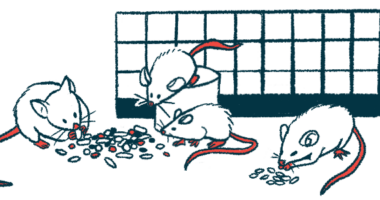CHIT1 Immune Protein May Be Marker of Response to Spinraza
Protein levels in children change over time on Spinraza: study

Levels of an immune protein called CHIT1 change over time in children with spinal muscular atrophy (SMA) who undergo treatment with Spinraza (nusinersen), a small study reports.
The findings thus suggest that the protein’s levels — in the cerebrospinal fluid or CSF, the liquid surrounding the brain and spinal cord — may be a marker of a child’s response to Spinraza treatment, according to researchers.
“We found that the CSF CHIT1 level changed over time, making it a potential biomarker of the treatment response and clinical course of SMA patients,” the team wrote.
The study, “Evaluation of cerebrospinal fluid biomarkers in pediatric patients with spinal muscular atrophy,” was published in Brain and Development.
Spinraza was the first disease-modifying treatment for SMA to become widely available. The therapy is delivered via injection through the spine every four months; it works to increase production of the SMN protein, deficits of which cause SMA. The medication is sold by Biogen, which was not involved in this study.
Here, researchers at Hiroshima University Hospital, in Japan, reported data from six children with SMA who were treated with Spinraza at their institution. When treatment was started, the children ranged in age from 1 month to just under 12 years old. Two of the children had type 1 SMA, while the others had type 2 disease.
Five of the six children experienced clinically significant improvement on standardized measures of motor function in the years after starting on Spinraza. The sixth child didn’t improve on standardized measures, though the researchers noted that she nonetheless did experience some subtle clinical improvements with treatment, including less need for ventilation and slightly better finger and wrist function.
CSF samples from each of the children were analyzed at the start of treatment, then again after one and two years. Levels of two pro-inflammatory signaling molecules called TNF-alpha and IFN-gamma did not change with treatment. However, changes were noted in the levels of the CHIT1 protein in the CSF.
Specifically, one year after starting on Spinraza, some patients exhibited a dramatic increase in CHIT1 CSF levels. The other patients levels were largely stable.
Then, from treatment year one to year two, CHIT1 levels in all patients decreased.
“In our pediatric cohort, the CSF CHIT1 levels clearly decreased over time with [Spinraza] treatment during the second year, despite increasing during the first year, which correlated with motor functional improvement,” the researchers concluded.
The CHIT1 protein is normally made by certain immune cells in response to infection, and the researchers speculated that the initial increase in some patients “may indicate an immune response-like off-target reaction,” while the decrease seen later on suggests that treatment with Spinraza “may eventually reduce such neuroinflammatory processes and improve motor function.”
“To our knowledge, this is the first study showing the usefulness of CHIT1 in pediatric SMA,” the team wrote.
The scientists stressed, however, that these findings need to be taken in context as a preliminary study done in a small number of patients, and with no control group. “Larger multicenter patient cohorts are needed to confirm our findings,” they concluded.








